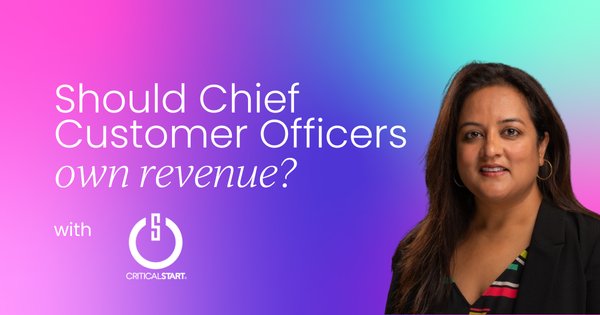This article is based on a keynote presentation Stuti gave at Chief Customer Officer Summit New York 2024. You can watch the full session and others from the event OnDemand with a Customer Success Collective membership plan.
As a Chief Customer Officer (CCO) with years of experience in the trenches of customer success (CS), I've witnessed firsthand the evolution of our role.
From the early days of software-as-a-service (SaaS) to the post-pandemic world, the landscape of customer relationships has dramatically shifted. That’s really what this article is about; I want to share my personal journey and make a case for why CCOs should own revenue.
- The evolution of customer success
- The case for Chief Customer Officers owning revenue
- Traditional customer success responsibilities vs. revenue ownership
- Revenue ownership models for Chief Customer Officers
- Implementing revenue strategies in customer success
- Learning from industry leaders
The evolution of customer success
The birth of SaaS revolutionized how we interact with customers. Gone are the days when high switching costs kept customers locked in. Now, with subscriptions and easy exits, the concept of churn has become a real threat. This shift demanded a new approach to customer relationships.
Companies like Salesforce and Gainsight played crucial roles in solidifying customer success as a discipline. They provided platforms and knowledge that helped us justify the importance of CS to our leadership teams. I still remember relying on Gainsight's resources to convince my executives that CS was more than just a buzzword.
However, it was the pandemic that truly highlighted the importance of existing customers. Suddenly, the "new business only" mentality wasn't sustainable. We realized that not only is it easier to sell to existing customers, but keeping them happy is crucial for long-term success.

Stuti’s personal journey in customer success
My customer success career began in a rather unexpected role: as an Escalation Manager. It wasn't glamorous by any means; I was essentially a buffer, taking angry customer calls so the CCO didn't have to. For some people, this would be their worst nightmare, but I loved it. Why? Because when you're dealing with customers who are most frustrated, there's nowhere to go but up!
From there, I moved into more proactive roles, learning to prevent issues before they escalated. I was fortunate to have a mentor from the West Coast who opened my eyes to the potential of CS beyond just putting out fires.
At BitSight, I built a CS organization from the ground up, growing it from 23 to 75 people. Later, at OneSpan, a public company with over $300 million in revenue, I became their first CCO.
If you had asked me during my BitSight days if I'd ever want to own revenue, I would have said, "No way!" I considered myself a purist, focused solely on advocacy and adoption. But my perspective evolved organically. Now, if I don't own revenue, I'm not taking the job.

The case for Chief Customer Officers owning revenue
So, why the change of heart? It comes down to impact and influence.
As CCOs, we often talk about being the voice of the customer. We focus on adoption, usage, and advocacy. These are crucial, but they're not always quantifiable. In the boardroom, without revenue responsibility, we're often just another input. Someone else can easily dismiss our insights with a casual, "I don't know what they're talking about. I just talked to a customer yesterday, and they loved us!"
When customer initiatives are tied to revenue, they become priorities, not just nice-to-haves. If I can say, "We can't meet our $100 million renewal revenue target unless we address these customer needs," that's powerful. It moves us beyond being a cost center to being a value center.
At OneSpan, this shift allowed me to create experience packages that self-funded my entire organization during a period of layoffs. I didn't have to ask for headcount – I could predict my needs based on incoming revenue.
Owning revenue also gives us accountability for the customer lifetime value (CLV). How many times have you seen sales make a heavily discounted deal, only for CS to bear the burden of supporting a low-value customer? When we own revenue, we can influence these decisions and truly optimize for CLV.

Traditional customer success responsibilities vs. revenue ownership
Don't get me wrong, traditional CS responsibilities like being the voice of the customer, driving adoption, and fostering advocacy are still crucial. But without quantifiable metrics and ownership, it's hard to influence organizational priorities.
Customers don't care about our internal structures. They don't want to know if they're talking to a CSM or sales rep. They just want a partner who can help them achieve their desired outcomes without constantly trying to sell them something new.
Revenue ownership models for Chief Customer Officers
In my experience, there are three main models for revenue ownership in CS:
- Sales-led revenue
- CS-led expansions and renewals
- Dedicated account management team
Sales-led revenue
In this model, all commercial activities are handled by sales, while CS focuses on adoption and usage. This can work well for complex solutions with long sales cycles and renewals as complicated as the initial sale.
CS-led expansions and renewals
Here, new logos are owned by sales, while CS handles expansions and renewals. This model works well when pricing is straightforward, and processes are clear-cut.
Dedicated account management team
This model adds a separate account management team under the CCO. It's more complex but can be effective for massive enterprise customers with complex environments.
Each model has its pros and cons, and the right choice depends on your specific situation. The key is to find a structure that allows CS to drive value while maintaining a focus on customer outcomes.

Implementing revenue strategies in customer success
Once you've decided to own revenue, how do you approach it? Here are a few strategies:
- Personalization and segmentation: This is crucial. While I still believe in revenue-based segmentation, it's important to look beyond just numbers and consider the total lifetime value of a customer.
- Cross-functional collaboration: Work closely with product, sales, and marketing teams. You can't drive revenue in isolation.
- Data-driven decision-making: Use data to secure your information, test your approaches, and prove what works. A/B testing can be incredibly powerful here.

Learning from industry leaders
We can learn a lot from companies that have successfully integrated CS and revenue:
- Amazon has leveraged personalization and segmentation to drive massive revenue growth.
- Salesforce aligned its customer success with revenue, focusing on upselling and creating a platform to support these efforts.
- Microsoft has built a brilliant CS organization that uses data analytics to drive a more customer-centric approach.
KPIs for revenue-owning CCOs
While traditional CS metrics like NPS and CSAT are still important, revenue-owning CCOs need to focus on financial KPIs as well. These might include:
- Net revenue retention
- Gross revenue retention
- Expansion revenue
- Customer lifetime value
Remember, nobody asks a CFO to justify their role. By tying our work to these metrics, we secure our place at the executive table and gain a deeper understanding of the end-to-end process.

What have we learned?
The evolution of the CCO role reflects the changing dynamics of customer relationships in the SaaS world. As we move from being seen as cost centers to value drivers, owning revenue becomes not just an option, but a necessity.
My journey from skeptic to advocate for revenue ownership wasn't overnight. It was an organic evolution driven by the realization that to truly advocate for our customers and drive outcomes, we need to speak the language of the business - and that language is revenue.
For CS leaders considering this shift, remember: owning revenue doesn't mean abandoning our core principles. It means aligning customer success with business success, giving us the power to truly drive change and deliver value.
Like what you've read?
If you enjoyed this fresh perspective from Stuti, then this article is just the tip of the iceberg. You can feast your eyes on white-hot insights like this and more – all geared toward the specific needs of C-suite executives – with a ticket to our Chief Customer Officer Summits.



 Follow us on LinkedIn
Follow us on LinkedIn




